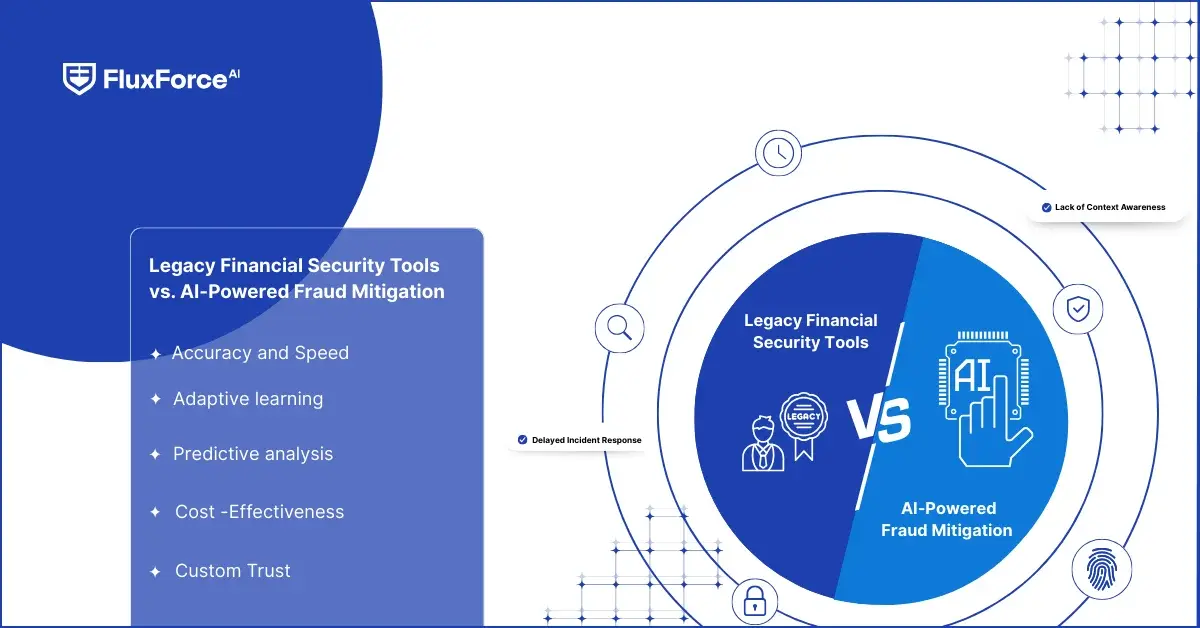Listen To Our Podcast🎧

Introduction
With global banking fraud losses nearing $500 billion annually, the effectiveness of fraud prevention is a major concern for organizations. The choice between traditional legacy security tools and advanced AI-powered solutions is a pivotal one, as each approach has distinct impacts on an organization's ability to protect assets and ensure operational integrity.
This article explores the fundamental differences between these two methodologies, primarily focusing on the impact on operational distinctions, inherent limitations, and key advantages of both legacy and AI-based fraud detection systems.
As financial institutions face increasingly sophisticated fraud schemes and regulatory pressures, understanding these contrasting approaches becomes essential for strategic decision-making.
Traditional Fraud Prevention in Financial Institutions
Legacy fraud prevention techniques are known for flagging suspicious activity based on exceeding thresholds or moving against predefined patterns. In financial institutions, two core mechanisms dominate these traditional frameworks:
1. Rule-Based Monitoring:
Traditional systems flag transactions if they:
- Violate pre-set transaction limits.
- Matches with fraud patterns.
- Identified under blacklists and global datasets.
These systems are straightforward to implement and explain, which makes them audit-friendly and compliant with regulatory requirements. They provide predictability, but to a limited extent.
2. Manual Review Processes:
Human analysts then review transactions flagged by the system. They further:
- Validate suspicious activity using experience and context.
- Assess risk that rules alone cannot capture.
- Decide on escalation or intervention based on nuanced judgment.
Limitations of Legacy Financial Security Systems

With fraudsters evolving faster in the digital age, the traditional approach often presents operational and regulatory complications due to its slow and ineffective processes. These include:
- High False-Positive Rates: Traditional monitoring systems generate excessive false alerts, often around 70%, overwhelming analysts and delaying legitimate customer transactions.
- Lack of Adaptability: Static rule-based systems cannot adjust quickly to new fraud patterns, leaving financial institutions exposed to evolving, complex attack strategies.
- Scalability Challenges: As transaction volumes surge, reliance on manual review and rigid frameworks drives higher operational costs and slows fraud detection processes.
- Compliance Pressures: Regulatory demands for transparent, real-time fraud monitoring are difficult to meet with outdated systems, increasing risks of penalties and reputational harm.
AI-Powered Fraud Mitigation in Financial Institutions
Integrating AI for banking security enables scalable, real-time financial fraud prevention. By moving beyond static thresholds, it leverages modern technologies to increase efficiency, adapt to evolving patterns, and automate compliance processes.
Four core AI features that drive modern fraud mitigation are:

1. Machine Learning Fraud Detection:
Advanced machine learning models analyse vast transaction datasets in real time to:
- Detect anomalies beyond fixed rules.
- Identify new fraud patterns as they emerge.
- Reduce false positives through adaptive learning.
2. Predictive Analytics for Fraud Mitigation:
By continuously monitoring transaction behaviour and its patterns, predictive models:
- Anticipate fraud before it occurs.
- Score transactions based on the probability of risk.
- Provide proactive alerts to limit financial exposure.
3. Advanced Identity Verification with AI:
For subtle banking fraud prevention, AI-powered systems:
- Scan documents, fingerprints, and live selfies.
- Flag identity inconsistencies instantly.
- Secure digital channels against account takeover.
4. AI-Driven Compliance Solutions:
AI automates compliance to keep institutions ahead of fraud regulations by:
- Monitoring transactions against global standards in real time.
- Generating transparent, auditable compliance reports.
- Reducing dependency on manual oversight.
Benefits of AI in Banking Fraud Detection
While AI implementation demands significant initial investment and technical expertise, its long-term impact on banking security delivers significant and lasting value.

- Reactive to Proactive Threat Detection: AI identifies suspicious activity before it becomes a problem, enabling institutions to prevent financial losses. Real-time monitoring and predictive algorithms allow faster and more accurate responses to emerging fraud threats.
- Automated Regulatory Compliance: AI automates adherence to KYC, AML, and data protection regulations, generating audit-ready reports and reducing manual oversight.
- Reduced False Positives: Well-trained AI models accurately differentiate legitimate transactions from fraudulent activity, minimizing unnecessary alerts and account freezes. This enhances both operational efficiency and customer experience.
- Efficient Operations: AI handles high transaction volumes 24/7 without fatigue, automating complex investigations. Analysts can focus on strategic decisions, high-risk cases, and customer engagement, optimizing both resources and outcomes.
Legacy Tools vs AI-Based Fraud Detection Comparison

In digital-led banking environments, an effective fraud prevention framework blends accuracy, speed, and regulatory compliance. Understanding the comparison below of legacy and AI-based approaches shows how each method influences risk management, operational efficiency, and adaptability.
Future of Fraud Prevention in Financial Institutions
The impact of legacy tools in finance, in contrast with AI-powered solutions, highlights a shift from static, rule-based monitoring to intelligent, adaptive fraud detection. Legacy systems ensure compliance and predictable outcomes, but struggle with evolving threats and large transaction volumes.
AI solutions offer real-time monitoring, predictive analytics, and automated decision-making, enabling faster responses, reduced false positives, and more efficient operations across increasingly complex financial ecosystems.
Key Trends Shaping the Future:
- Predictive and Adaptive Systems: AI will anticipate fraud before it occurs, continuously learning from emerging patterns.
- Automation and Integration: Fraud detection will be fully integrated across channels, reducing manual interventions and improving operational efficiency.
Onboard Customers in Seconds

Conclusion
Financial fraud prevention is shifting from static, rule-based legacy systems to AI-powered, integrated solutions. Legacy tools remain useful for defined scenarios but struggle with scalability, adaptability, and high false-positive rates.
AI-powered fraud mitigation combines machine learning, predictive analytics, and real-time monitoring into a single framework. For digital banking fraud detection, the results in detection accuracy, response times, and regulatory compliance are unmatched by traditional procedures.
By the year 2025, AI and automation are expected to become standard components of cybersecurity for financial institutions.






Share this article